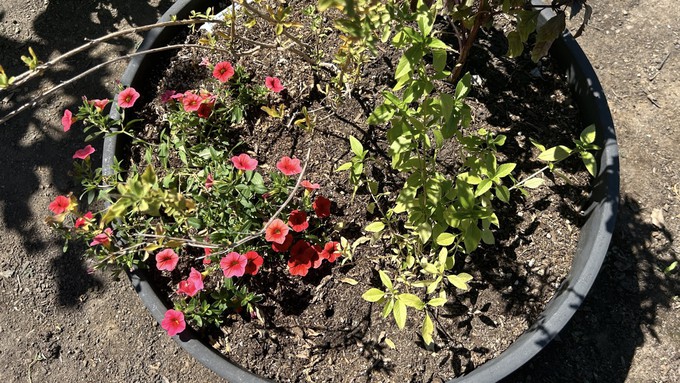
Get growing with more pleasure and fun

Easy-care plants in a large planter combine two of the ways to reduce labor in the garden. Kathy Morrison
All work and no play makes gardening pretty dull – and less fun. If it seems all you do is pull weeds, where’s the pleasure in growing vegetables and flowers?
On this Labor Day, let’s consider how you spend your time (and labor) in your garden. There are lots of ways to cut down on maintenance and increase production – and joy.
With that in mind on this holiday, here are five labor-saving ideas for your garden:
1. Mulch, mulch, mulch!
This simple step saves moisture, cuts down on weeds and helps plants cope with fluctuating weather. Use organic material (straw, leaves, bark, etc.) and that mulch adds nutrients to the soil, too. Avoid rocks or gravel as mulch; they retain too much heat in Sacramento and can “cook” plant roots. You also can use fallen leaves as mulch – cutting down on another fall chore.
2. Smart irrigation.
Stop dragging hoses. Instead, install drip lines and a “smart” irrigation controller. Drip irrigation puts water where plants need it most – at the roots. A smart controller takes the guess work out of watering. Cued into weather, it also can turn irrigation off when not needed such as during rainy weather – no more wasting water. Here’s another plus: Rebates are available in most local water districts. Check availability at https://bewatersmart.info/.
3. Use bigger pots.
The larger the container, the less frequently it needs watering. It also makes a greater visual impact and allows plants more room to grow.
4. Choose lower-maintenance, slow-growing plants.
Tired of pruning hedges? Constantly edging borders? Mowing the lawn? Transition your landscape to plants that need less fuss and snipping. It’s a matter of putting the right plant in the right place; it will grow healthier and need less care, too.
5. Plant perennials and bulbs.
What’s more time saving than flowers that come up every year with no additional work? Fall is planting season for daffodils, tulips, hyacinths and other spring-blooming bulbs as well as most perennials. Naturalized bulbs can make a big, colorful splash in your garden year after year. With staggered blooming seasons, perennials add low-maintenance flowers to beds year round. Another bonus: Bulbs and perennials tend to need less irrigation – save water and time, too.
Comments
0 comments have been posted.Sacramento Digs Gardening to your inbox.
Food in My Back Yard Series
May 6: Maintain soil moisture with mulch for garden success
April 29: What's (already) wrong with my tomato plants?
April 22: Should you stock up on fertilizer? (Yes!)
April 15: Grow culinary herbs in containers
April 8: When to plant summer vegetables
April 1: Don't be fooled by these garden myths
March 25: Fertilizer tips: How to 'feed' your vegetables for healthy growth
March 18: Time to give vegetable seedlings some more space
March 11: Ways to win the fight against weeds
March 4: Potatoes from the garden
Feb. 25: Plant a fruit tree now -- for later
Feb. 18: How to squeeze more food into less space
Feb. 11: When to plant? Consider staggering your transplants
Feb. 4: Starting in seed starting
Sites We Like
Garden Checklist for week of May 11
Make the most of the lower temperatures early in the week. We’ll be back in the 80s by Thursday.
* Plant, plant, plant! It’s prime planting season in the Sacramento area. Time to set out those tomato transplants along with peppers and eggplants. Pinch off any flowers on new transplants to make them concentrate on establishing roots instead of setting premature fruit.
* Direct-seed melons, cucumbers, summer squash, corn, radishes, pumpkins and annual herbs such as basil.
* Harvest cabbage, lettuce, peas and green onions.
* In the flower garden, direct-seed sunflowers, cosmos, salvia, zinnias, marigolds, celosia and asters. (You also can transplant seedlings for many of the same flowers.)
* Plant dahlia tubers.
* Transplant petunias, marigolds and perennial flowers such as astilbe, columbine, coneflowers, coreopsis, dahlias, rudbeckia and verbena.
* Keep an eye out for slugs, snails, earwigs and aphids that want to dine on tender new growth.
* Feed summer bloomers with a balanced fertilizer.
* For continued bloom, cut off spent flowers on roses as well as other flowering plants.
* Add mulch to the garden to maintain moisture. Mulch also cuts down on weeds. But don’t let it mound around the stems or trunks of trees or shrubs. Leave about a 6-inch-to-1-foot circle to avoid crown rot or other problems.
* Remember to weed! Pull those nasties before they set seed.
* Water early in the day and keep seedlings evenly moist.